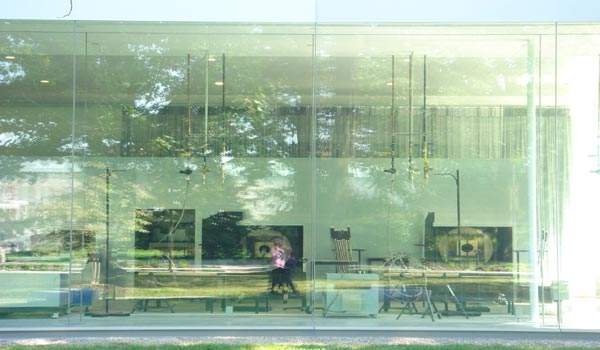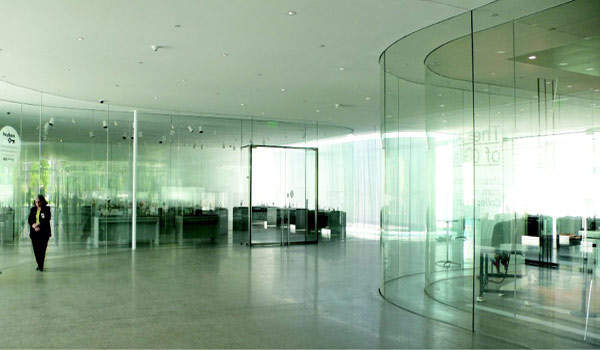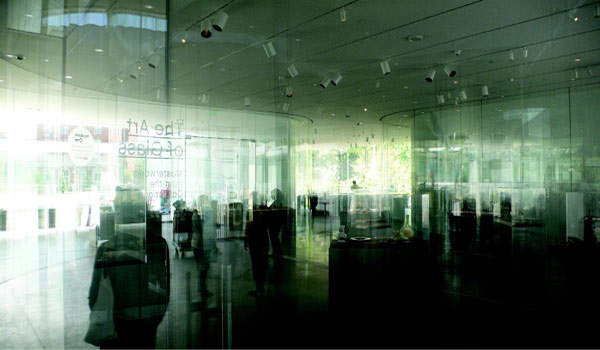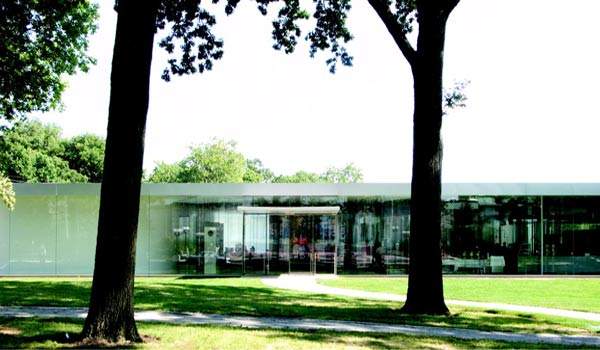The Toledo Museum of Art glass pavilion showcases glass artworks and glass-making studios. Architects Kazuyo Sejima and Ryue Nishizawa of the Tokyo-based architecture firm SANAA chose to design the building primarily out of glass. Except for opaque walls enclosing toilets, plumbing, roof drains, elevators, and diagonal bracing, all exterior and interior walls are made of curved glass.
Completed in 2006, the glass pavilion in Toledo, Ohio (USA) is an annexe across the street from the Toledo Museum of Art. The pavilion was the first US building by SANAA, who also designed the 2007 New Museum of Contemporary Art in New York, a pile of offset boxes. That project also features a partially glass exterior, although a metal mesh façade gives the building a more solid look.
The Toledo project lies in a park, next to a century-old grove of trees. SANAA avoided cutting any of them. The glass walls of the single-story building give museum-goers a sense of connection to the trees.
Structural components
Except for delicate steel columns, the building structure is hidden above the ceiling. One interior volume also contains a solid plate steel wall that provides lateral bracing. The light roof rests on these structural members, so the glass walls bear no load, and the roof appears to float.
The façade features two parallel glass walls with a gap between them. And this aspect continues throughout the interior.
In a typical building, one wall divides two spaces. But in this museum, any two galleries have two walls of curving glass between them. A cavity of nearly 1m lies between the layers of glass. The size of the gap varies, because the walls curve in irregular ways for the sake of variety.
Daylighting
Using glass on this scale introduces a host of benefits and challenges. In most museums, sun control is essential, because ultraviolet light quickly fades paintings and fabrics. But when exhibited artworks are made of glass, the rules change.
A slightly reflective Verosol curtain inside the exterior wall contains aluminium particles that reflect heat, light and UV light out of the building.
After an extensive daylight analysis, SANAA created three internal courtyards. Glare generally comes about when there’s a high degree of light contrast, and the courtyards reduce glare by bringing daylight to the middle of the building.
Temperature control
In both exterior and interior walls, cavities between the layers of glass act as invisible insulation. That is, they collect any heat that penetrates the glass. The cavity air temperature remains somewhere between that of the exterior and interior temperature.
The glass ovens generate considerable heat. In the summer, fans pull heat out of the building. And in the winter, heat from the ovens enters the cavity and warms the rest of the building.
Acoustics
Noise bounces off hard surfaces such as glass. The acoustic plaster ceiling absorbs some of this noise. A movable interior curtain (used to make interior spaces bigger or smaller) also helps to deaden the noise.
Reflectivity
Concerned that the ultra-clear, low-iron glass would create dizzying, funhouse-type reflections, the design team did considerable daylighting studies, including computer modelling and full-scale mock-ups.
The finished building does have some reflections, but they help create a pleasant, nuanced experience. The reflections and varying light conditions filter the view through the building, making the glass transparent at times and reflective at others.
Fragility
The glass in the project originated in Germany, then went to southern China, where it was curved and laminated. From there, it travelled to Toledo.
The installed glass is quite strong and poses little danger of shattering. The exterior glass is 2.5cm thick. When the design team tested a full-scale mock-up by throwing rocks and bricks at it, the glass walls survived.







